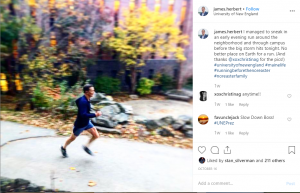Higher ed presidents on social: making it work
By Sharon Aschaiek | Oct. 30, 2019

When the leader of a higher education institution excels at social media, it can do wonders for the institution’s brand.
Recently, communications researcher and King’s University College communications manager Jane Antoniak surveyed university presidents and principals in Canada on their social media habits. The results showed that overall, “social media became a virtual open door to the ivory tower and it made [the president’s] office more transparent.”

But what does it take to develop and execute an effective social media strategy for a university or college president? We can learn a lot from Louise Coburn, the social media strategist for the University of New England in Maine. Her responsibilities include directly supporting the social media efforts of UNE president James D. Herbert. Coburn presented on this topic at the recent 2019 HighEdWeb conference in a session called The Social Contract: Managing a President’s Digital Persona.
Developing rapport
For a social media strategist to have a productive working relationship with a school president, Coburn says, a high level of trust is needed in order to build rapport. The pace of this process partly depends on how comfortable a president is with communicating on social. Fortunately for Coburn, Herbert is by nature a social person who deeply understands the value of these platforms in helping him expand his reach to stakeholder groups.
“President Herbert wants to know the students, the grad students, the parents, our staff and faculty. He understands that social platforms help him engage with more people. He wants people associated with the university to feel connected to him,” Coburn says. “So I didn’t have to do any convincing about the benefits.”
When Coburn first began collaborating with Herbert on social media, they discussed how to ensure his social posts relate to and support the broader objectives of the university. From there, they established specific goals to achieve, and planned the types of content to share, the audiences to target, and how frequently to post.
They also determined which channels he would use to reach specific audiences: Instagram for students, Facebook for parents, and Twitter for the wider UNE community and the public. He is most active on Instagram, and altogether posts on all platforms four to five times a week, though sometimes he posts multiple times per day.
Keeping it real
One of the key reasons Herbert’s social media posts tend to resonate with his followers is that he comes across as authentic. This is a key part of Coburn’s strategy, and she has worked with Herbert to identify the traits and interests he would feel comfortable sharing with the public.
“It’s important to figure out early what the president’s voice will be,” Coburn says. “President Herbert is willing to be personal, and his personal posts are the most popular.”
She says some of the posts that have resonated the most are Mother’s Day tributes to his mother and wife, and one in which he mentioned he is a first-generation university graduate. Below are other posts that have struck a chord.


Paying attention
Herbert and Coburn work together to create content, increase followers and align posts to Herbert’s voice and to the institution’s brand. To ensure the messaging she uses matches his style and tone, she studies how he communicates and interacts with others, and maintains a spreadsheet of the most common words and phrases he uses.
Coburn checks his calendar two to three times a day, and identifies events and situations that would lend themselves well to meaningful social media moments. She also ensures the right images accompany his posts, and reviews any photos taken of him at events before they get posted.
Given Herbert’s demanding schedule, he and Coburn tend to communicate by text. Through the course of a day, they exchange messages about potential ideas for social posts. While Herbert directly responds to those who comment on his posts, Coburn also monitors community engagement and points out comments he may have missed.
Being flexible
Coburn makes it clear that being a university social media strategist is a not a 9-to-5 job. While she has support staff—a part-time employee and an intern—she describes the job as 24/7. But she says her respect and admiration for Herbert and their collaborative working relationship make the hard work worthwhile.
“He is great to work with. Right away I liked and respected him. I like his wife. And it’s reciprocal—he know my kids’ names and birthdays,” she says. “He has been very open with me about what he wants to do on social, and he uses me as an expert and takes my advice. So it’s a very rewarding work relationship.”